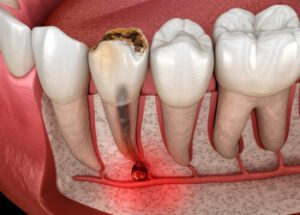Tooth pain is never fun, but knowing whether you need a simple dental filling or something more complex like a root canal treatment can help you act quickly and save your natural tooth. While both treatments address tooth decay and damage, they target different parts of the tooth. So, how do I know if I need a root canal or a filling?
In this blog, we’ll guide you through the tell-tale signs, common symptoms, and everything you need to know to decide when it’s time to seek treatment. Whether it’s a minor dental decay or an infected pulp, understanding your symptoms could save you from tooth loss and further complications.
What’s the Difference Between a Filling and a Root Canal?
Let’s start with the basics.
A dental filling is used when the decay is relatively small and hasn’t reached the soft tissue inside your tooth. It typically involves removing the decayed portion and sealing the hole with a material like composite resin.
A root canal procedure, on the other hand, becomes necessary when the decay or damage has reached the tooth’s pulp, which contains blood vessels, connective tissue, and nerves. Once the dental pulp is infected or inflamed, a simple filling won’t be enough. You’ll need endodontic therapy to clean out the infected area, preserve the natural tooth, and prevent further damage.
The Early Signs: When a Filling Might Be Enough
 If your toothache is mild or occasional, it might be time to see your dentist for a dental filling. Some of the early signs that a filling may be sufficient include:
If your toothache is mild or occasional, it might be time to see your dentist for a dental filling. Some of the early signs that a filling may be sufficient include:
- Mild pain when biting or chewing
- Localised sensitivity to hot or cold beverages
- A small, visible hole or dark spot on your tooth
- Minor tooth discolouration
- Slight discomfort with hot or cold temperatures, but it fades quickly
These are typically signs of tooth decay that haven’t yet reached the tooth pulp. With prompt treatment, your dentist can remove the decay, place filling material, and restore the damaged tooth without needing more invasive care.
When the Pain Gets Worse: You Might Need a Root Canal
Now, let’s talk about red flags that could point to an infected tooth or infected pulp. These symptoms often indicate that decay or damage has reached deeper into the root canal system, and a dental filling simply won’t be enough.
Watch out for the following:
- Severe tooth pain that throbs or keeps you up at night
- Prolonged sensitivity to hot or cold beverages
- Pain that lingers long after the local anaesthetic wears off
- Swelling or swollen gums near the affected tooth
- A loose tooth with no clear injury
- A small, pimple-like swelling on the gums, often referred to as a dental abscess
- Pain that extends to the jaw or ear
- Tooth discolouration in one particular tooth
- A visible crack or fractured tooth
These signs may suggest that the tooth’s pulp is inflamed, dying, or dead due to infection, injury, or deep decay. At this stage, a root canal treatment, also known as root canal therapy, is usually the only way to save the natural tooth.
So, Why Does the Tooth Pulp Matter So Much?
The dental pulp inside your tooth houses essential tissues like nerves, blood vessels, and connective tissue. When this area becomes infected or inflamed, it causes immense pressure and discomfort. Left untreated, dead pulp tissues can lead to abscesses, bone loss, and eventually tooth loss.
The purpose of a root canal procedure is to remove these infected tissues, clean and disinfect the root canal system, and fill it with a certain material to prevent further decay. A crown is usually placed afterwards to strengthen the damaged tooth.
How Do Dentists Decide Which Treatment You Need?
Your dentist will typically begin with:
- An oral exam: Checking for signs of decay, infection, and damage
- X-rays: To see the depth of the decay and whether it has reached the tooth pulp
- Thermal testing: Assessing sensitivity to hot or cold temperatures
- Percussion testing: Tapping the tooth to check for tenderness or pain
- Mobility tests: Evaluating whether the tooth is loose
Your dentist will evaluate your symptoms and test results to decide whether you need a tooth filling or root canal therapy.
What If You Delay Treatment?
 Delaying treatment for tooth pain or sensitivity can turn a simple problem into a complex one. A small dental cavity left untreated may evolve into an infected, dead tooth pulp requiring root canal therapy. Eventually, you might even face tooth loss and need more advanced procedures like implants.
Delaying treatment for tooth pain or sensitivity can turn a simple problem into a complex one. A small dental cavity left untreated may evolve into an infected, dead tooth pulp requiring root canal therapy. Eventually, you might even face tooth loss and need more advanced procedures like implants.
Symptoms such as mild pain or sensitivity are easier and more affordable to treat with dental fillings. Waiting until you experience severe pain or swelling will often lead to a more complex and costly dental procedure.
How Much Do These Treatments Cost?
While prices vary depending on the severity and your location, here’s a general idea of the cost difference:
- Dental filling: Starts from $150
- Root canal treatment: Starts from $800
The earlier you act, the more you can save, both in money and in preserving your oral health.
What to Expect During the Procedures
Dental Filling:
- Your dentist numbs the area with a local anaesthetic
- The decay is removed
- A composite resin or other material is used to fill the hole
- The area is polished and ready to use right away
Root Canal Procedure:
- A local anaesthetic is used to numb the area
- The infected pulp is removed
- The canals are cleaned, shaped, and filled
- A temporary filling or permanent restoration is placed
- A follow-up appointment may be required for a crown
Although many believe root canals hurt, the truth is quite the opposite. They are meant to relieve pain, not cause it. Local anaesthesia keeps you comfortable during the procedure, and with proper aftercare, most people return to eating normally, starting with soft foods, within a few days.
How to Protect Your Teeth from Needing Either
A little prevention can go a long way. Here are some easy ways to keep your teeth healthy and lower your chances of needing a filling or root canal:
- Brush twice a day with fluoride toothpaste
- Floss daily to remove plaque between teeth
- Rinse with an antibacterial mouthwash to help control harmful bacteria in your mouth.
- Limit sugary snacks and cold beverages
- See your dentist every six months for routine checkups and professional cleans.
- Avoid using your teeth to open packages or bite down on hard items.
- Address any tooth damage immediately
- Don’t ignore tooth pain, even if it seems mild
Practising good oral hygiene keeps your teeth strong and helps prevent both small issues and more serious dental problems.
Final Thoughts: Trust Your Dentist and Your Symptoms
 Still wondering, how do I know if I need a root canal or a filling? Here’s a simple way to think about it:
Still wondering, how do I know if I need a root canal or a filling? Here’s a simple way to think about it:
- If the discomfort is mild and doesn’t last long, it could be a job for a dental filling
- If you’re experiencing severe pain, persistent sensitivity, swelling, or visible damage, you may need a root canal
Either way, don’t try to diagnose it yourself. A dentist’s evaluation is essential for the right treatment. Catching issues early can save your natural tooth, reduce your pain, and avoid bigger dental bills later on.
Take Action Now
If you’re feeling unsure about that lingering toothache or sudden jolt of sensitivity, don’t wait for it to get worse. Book a dental appointment with Definitive Dental at (02) 6105 9833 and let a professional determine whether a filling or root canal treatment is right for you.
Your teeth are meant to last a lifetime; take the steps today to protect them.
Note: Any surgical or invasive procedure carries risks. Before proceeding, you should seek a second opinion from an appropriately qualified health practitioner.
References
- Cleveland Clinic. (n.d.). Tooth pulp. Retrieved from https://my.clevelandclinic.org/health/body/24659-tooth-pulp
- Mayo Clinic. (n.d.). Cavities/tooth decay. Retrieved from https://www.mayoclinic.org/diseases-conditions/cavities/symptoms-causes/syc-20352892
- Verywell Health. (n.d.). Which type of mouthwash works best? Retrieved from https://www.verywellhealth.com/which-type-of-mouthwash-works-best-4126424

